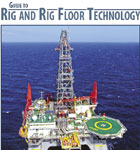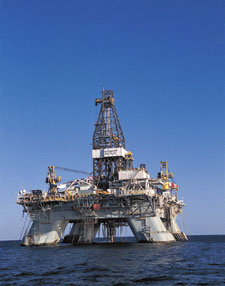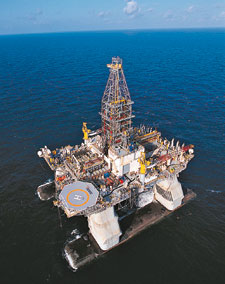New rig designs: Fifth-generation semisubmersibles
December 2004 Supplement New Rig Designs Fifth-generation semisubmersi
Fifth-generation semisubmersiblesSince Transocean’s 5th-Generation semisubmersible Deepwater Nautilus entered service, the rig has set multiple world records for the greatest water depths ever worked by an offshore rig in moored configuration. Once moored on the world water depth locations, however, the rig has utilized parallel operations, as well as teamwork, planning and communications, to achieve optimum operational performance. Built to operate on a pattern of eight mooring legs, Nautilus has a variable deck load (VDL) capacity of 9,400 mt, providing enough space to carry equipment, riser, conductor and casing to start a well and work through setting the BOP on the wellhead, quickly and efficiently. The rig’s unique design enables crews to work efficiently in several areas, such as operating with three strings of pipe simultaneously. While suspending 26-in. casing on the landing string in the marine riser tensioners on the starboard side of the rig, crews can also run 36-in. conductor through the main rotary table to spud the well and drill ahead. The string of 26-in. casing is run upon reaching location and during the primary mooring operations, another time-saving feature. It is run to a depth near the seafloor, which allows quick isolation of drilled formation after pulling out of the hole with the 30-in. bit. The speed and efficiency that reduce online time for rig operators are not objectives unto themselves. These activities also deliver the benefit of lowering the risk of a hole collapsing, by reducing time to isolate unprotected formations drilled in the riserless mode. When constructed in 2000, Nautilus was capable of working in water depths of 5,000 ft with self-contained mooring, and the rig has since used a preset mooring system to achieve world records in greater than 8,000 ft of water. The preset mooring system utilizes eight suction piles with polyester mooring lines, which are deployed by an anchor-handling vessel in advance of the rig’s arrival. These lines are connected to each of the rig’s mooring wires to form a taut mooring system. Nautilus first went to work for Shell in the US Gulf of Mexico and, on the rig’s first location, set a world record moored drilling depth of 7,785 ft of water in Alaminos Canyon 557. Since, the rig went on to set three world records for deepwater drilling in a moored configuration in Alaminos Canyon: 8,009 ft in Block 857; 8,070 ft in 813; and 8,717 ft again in 857. The current world water depth record in moored configuration, set in May 2004, is 8,951 ft in the Eastern Gulf of Mexico. Deepwater Nautilus also holds the world record water depth for a subsea completion in 7,570 ft of water for Shell and its partners BP and Petrobras, completing two wells on the NaKika-coulomb project. Once again, this record was achieved with optimal performance, as these tasks were completed in 13 and 17 days consecutively, generating significant savings. Of note, the NaKika-Coulomb development resulted from a discovery well drilled for Shell by the Transocean drillship Discoverer Seven Seas in 7,250 ft of water in 1987 in Mississippi Canyon Block 613. At the time, that water depth was a world record. One of 13, 5th-Generation deepwater drilling rigs owned and operated by Transocean, Deepwater Nautilus was recently blown off location 73 miles by Hurricane Ivan in mid-September, suffering damage to the mooring system, a communications unit and electrical paneling in the engine room. By late October, the rig was back on location to conduct exploration drilling for Shell, moored in a record 8,951 ft of water.
Another of Transocean’s 13, 5th- generation deepwater rigs is the Deepwater Horizon semisubmersible. On this rig, the team is helping lead the way in drill pipe tripping, one important candidate area for operational improvement. After seven initial batch-set wells in the US Gulf on BP’s Atlantis project earlier this year, crews on the rig’s next eight wells met or exceeded Transocean’s benchmark for tripping pipe of 2,300 ft/hr. On one well, crews tripped pipe at 4,089 ft/hr, almost 178% of the company’s benchmark. That rate was the maximum speed achievable with the equipment configuration being used on the rig. The average tripping rate during the eight consecutive wells was 2,920 ft/hr, 127% of the contractor’s benchmark. Horizon is dynamically positioned with a nominal drilling depth capability of 30,000 ft and a water depth capability, with upgrades, of 10,000 ft. The rig can also work in harsh environments, though it has worked exclusively in the US Gulf since being placed into service in 2001. |
|||||||||||
- Coiled tubing drilling’s role in the energy transition (March 2024)
- Using data to create new completion efficiencies (February 2024)
- Digital tool kit enhances real-time decision-making to improve drilling efficiency and performance (February 2024)
- E&P outside the U.S. maintains a disciplined pace (February 2024)
- Prices and governmental policies combine to stymie Canadian upstream growth (February 2024)
- U.S. operators reduce activity as crude prices plunge (February 2024)
- Applying ultra-deep LWD resistivity technology successfully in a SAGD operation (May 2019)
- Adoption of wireless intelligent completions advances (May 2019)
- Majors double down as takeaway crunch eases (April 2019)
- What’s new in well logging and formation evaluation (April 2019)
- Qualification of a 20,000-psi subsea BOP: A collaborative approach (February 2019)
- ConocoPhillips’ Greg Leveille sees rapid trajectory of technical advancement continuing (February 2019)





